RESEARCH EXCELLENCE INITIATIVE
FREEDOM OF RESEARCH – SCIENCE FOR THE FUTURE
‘Freedom of Research – Science for the Future’ series consists of articles, interviews and short videos presenting research conducted by winners of the call for proposals
Paulina Poczęta, PhD, DLitt, Assoc. Prof.
Restore the unwanted
Paulina Poczęta, PhD, DLitt, Assoc. Prof. from the Faculty of Arts and Educational Science implements her project on artistic fabric as part of the second edition of the ‘Freedom of Research’ call for proposals. We would like to invite you to read the article on the academic and artistic activities of the researcher from the University of Silesia, who runs a unique activities studio and a drawing atelier at the faculty.
| Paulina Poczęta, PhD, DLitt, Associate Professor |
The experiment with the fabrics of second-hand clothing, depicting human bodies on everyday clothes, underwear or bedding, with pictures of more or less adored idols with smiling faces and the accompanying slogans of happiness, strength and power, for me means a search for a new form of artistic creation in the broadly understood experimental fabric. A three-dimensional patchwork of shredded pop culture images, sewn together with a hand and machine stitch, becomes an attempt to introspect the body as subjectivity by turning our outer shell – everyday clothes and the image we create through it.
The beginning of work with recycled, printed fabric
Smiling faces, bulging eyes and slogans of happiness at some point became for me a strong creative and liberating imperative. In the women’s department of one of the many second-hand shops in Bielsko-Biała, I came across an extremely nasty T-shirt with a large, photographic print depicting a squatting, skimpily dressed, young and supposedly smiling woman. At the bottom of the shirt there was a print: ‘It’s cool to be kind.’ I bought this T-shirt and cut out the woman’s face, sewed a small pillow and wondered what to do next. This is how I started working on the series ‘grapes of guilt’ (literally: grapes of wine, as ‘winne’ in Polish means both ‘wine’ and ‘guilty’), in which faces emerge from the prints of used clothes, taking the shape of plant parts – buds waiting for the best time to bloom. Many of these faces have their eyes and mouths sewn shut. From inscriptions and slogans that often accompany these intrusive carnal images, I started to create my collection of clothes entitled ‘Trash talk’ (literally: ‘cloth talk’). This is my own, truly uncomfortable haute couture. Clothes/objects that are difficult to move around attract attention with their multitude of inscriptions, but also with the bizarre sculptural form. Stuffed like down-filled jackets, they restrict movement, slow down walking and, I hope, make you think: what can humans do to present the right image of themselves. How many of us are really created in us like this?
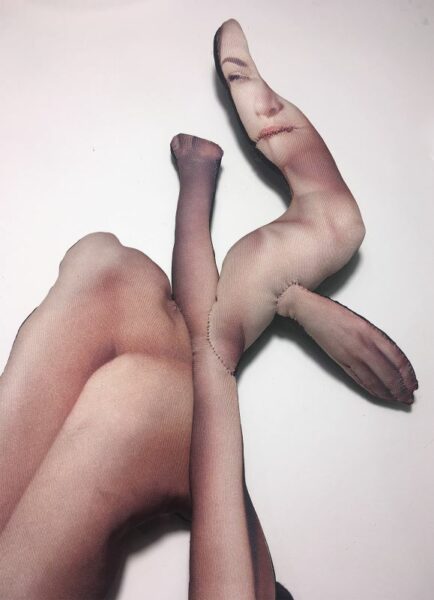
Piece of work ‘Grape of Guilt’ | Photo: author’s private archive
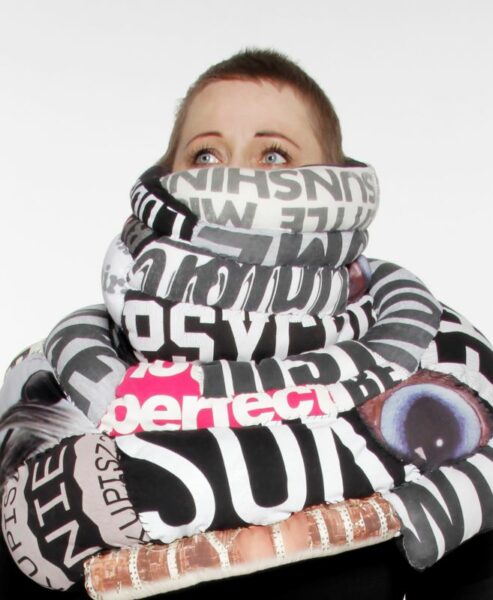
‘Trash talk’ | Photo: author’s private archive
Daily routine practice
My first series, in which I used fragments of second-hand clothing, was called ‘The Socks Lesson’ – almost a hundred collector’s display cases filled with mini-objects with photographs of people, showing through the layers of worn-out clothes.
Socks create interesting patterns of small abrasions and holes. I use these patterns when designing graphics in the linocut technique. Just like the human body consisting of many cells that constitute one organism, the fabric has its own warp – scaffolding and weft, which consist of its visual layer. Our bodies wear out like the textile clothes we wear every day. The ageing process affects each of us, which is why I chose this theme in my projects. I believe that it accurately illustrates the degradation and changes that take place in us, as well as diagnostic imaging of our bodies, e.g. ultrasound or other radiation methods, and at the same time, in my opinion, it is interesting in the visual layer. Worn clothes and underwear are culturally, sociologically and aesthetically our most important shell.
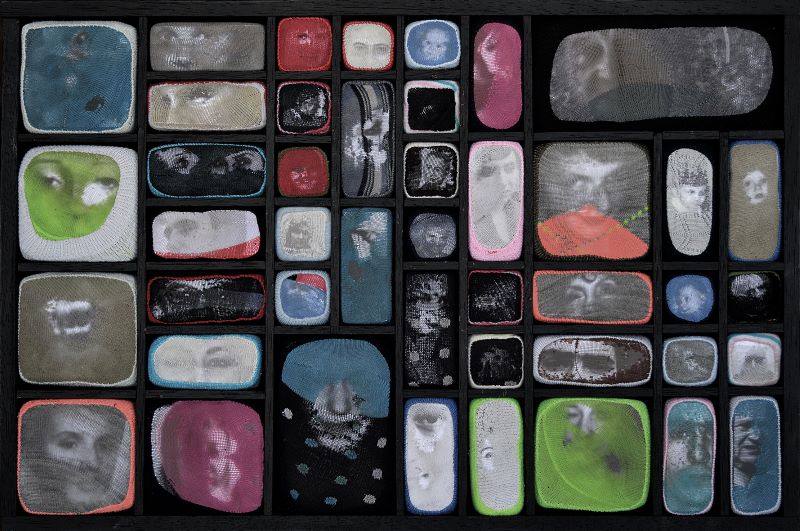
Part of the cycle ‘The Socks Lesson’ | Photo: author’s private archive
The pandemic and its impact
The object ‘Biogram’ was created during the pandemic period of my isolation (2020–2021), during which I missed direct contact with people, even though I like solitude. The clothes, underwear and bedding with imprints of human bodies, found in second-hand clothes shops, became a material of fusion with strangers. I cut out fragments of nameless bodies from printed images and sewed them together, smelling and touching used materials that previously covered bodies of strangers, but they became somehow close to me in the new reality of distance and isolation. I wasn’t afraid of infection, I was afraid of the contagious panic of fear. Surprisingly, during the pandemic, my favourite second-hand shops were open even on Sundays, as if beyond the regulation of raging fixation. I used to go there and freely observe others. What do we choose, how do we dress, what do we buy in these extraordinary times?
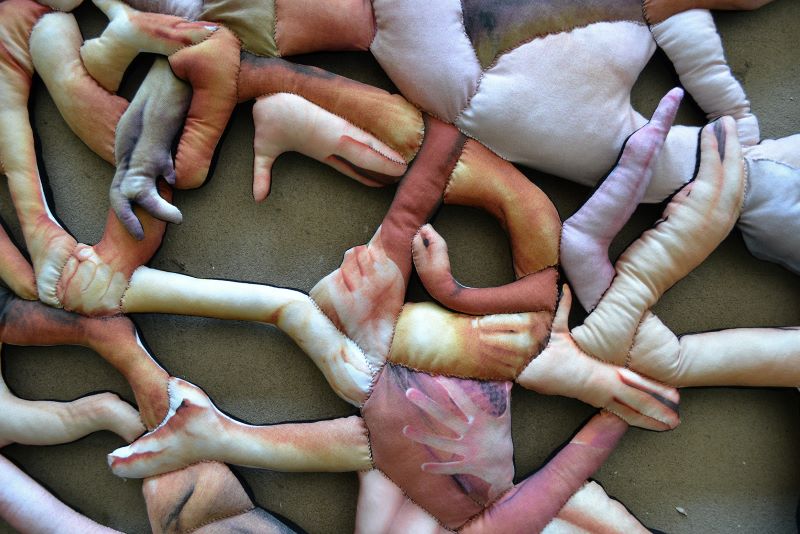
Piece of work ‘Biogram’ | Photo: author’s private archive
Work entitled ‘get stuffed’
A multi-element work, including participation in the ‘Freedom of Research’ call for proposals, helped me to increase the scope of the project. A large, sewn object consisting of several smaller ones, resembling lava in which images, faces, bodies with inscriptions often found on clothing prints are mixed together. I always start the creation process by looking for the right clothes with prints and texts. From the printed parts of these fabrics, I sew forms that resemble uncomfortable wardrobe/clothes, such as slogans and messages from clothing which I consider unacceptable – sexist, non-ecological and consumerist. I take pictures of myself wearing the clothes/works that I have created and then stitch them together with the previous fragments, creating an expanding installation of irregular shapes of three-dimensional soft objects.
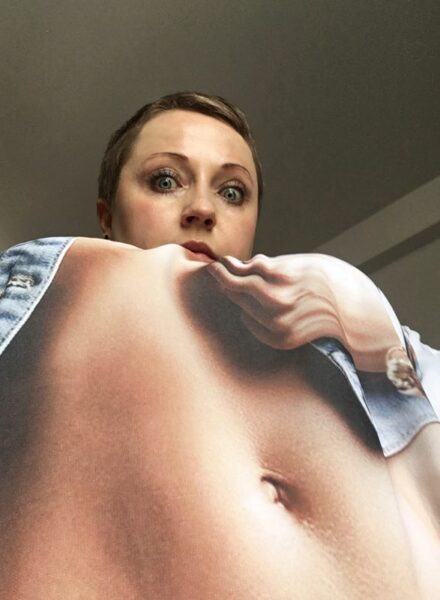
My work with fabric is like a spiritual practice, as I regularly do needle and thread exercises that help me to explore my/our nature of being. In my artistic activities, I allow reused fabric to become a new body that has already left its mark on it. Stains, abrasions, discolorations from sweat, second-hand clothes – this is life that can become a sense-creating building material of artistic work and serve for research. I want to find my own, original technique of sewing, constructing three-dimensional objects and using them to build expanding image installations. My dream is to implement new designs of ecological fabrics. The photographed, processed fabric can become a design for a new print/motif, which, on the one hand, will be visually intriguing, and on the other hand, will deny common overproduction.





